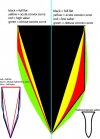I understand the diff between saber and flat. What is hollow? (This is even though I have an SK

Also, which is the most difficult to grind and what is the relative pro/cos of saber, vs flat vs hollow?
Thanks (I realize this has probably been discussed ad nauseum somewhere on this forum, but figured I'd ask since this thread is up).
some basic pro's and cons -
convex - strength. if you have a full convex with a 1/4" spine that terminates at 1.4mm thickness directly behind the edge vs. a full flat 1/4" spine that terminates at 1.4mm thickness directly behind the edge - the convex will simply have more metal due to the outward curve. Convex edges can also lower the chance of a blade binding (getting stuck in) wood because the wood is exerting force over a single line of metal on the curve, rather then the entire surface of the blade.
saber - depends on the heigth, but basically trying to mix strength and cutting performance without a convex edge. That same blade with a 1/4" spine that terminates at 1.4mm thickness directly behind the edge with a half heigth saber grind - I dont know wich will have more metal. Depends on how much of a convex it is, if its a wide curve, they could have the same amount of metal, just redistributed, if its a very shallow curve, then the half heigth saber could have way more metal making it much stronger. Generally, I look at half heigth sabers as useful for 3 things (and only 3 things) - strength in a prybar knife, maintaining weight for chopping applications (rather then increasing the spine thickness), or maintaining strength in a thin blade (such as the 1/8" thick NARK). It does put a corner where the media rubs against as you cut, and you do have to shove your material apart within the distance from the edge to the half way point in the blade. on certain designs like the older public defender that was very noticable, since you went from 0 to 3/16" thick in about 3/4".
High saber - It's stronger then full flat. you get good cutting performance out of it, but still maintain an area of full spine thickness. addding that little bit of thickness at the upper portion of the blade can add weight for chopping ability without lowering its cutting performance noticably. it's also easthetically pleasing

Full flat - Good cutting performance. It can be a little bindy depending on other elements, such as blade heigth, coating, and what the media being cut is like (hard vs. soft wood, fresh or seasoned). When your spine is thick enough (1/4, 5/16", 3/8"), a full flat may be preferable to saber or convex to keep the weight down while maintaining the strength of the thick spine. It can also be used to help keep the blade balance neutral, since a full tang handle will be at full thickness, leaving a big ol' block of steel at the handle, pulling the center of balance towards the hand. An example being the HOGFBMLE with magnum handles. to me its almost completely neutral, not really giving away its actual weight. If you made it into a 3/4" heigth saber (wich I would LOVE!), the 3/8" thickness at the top of the blade would help to add overal weight, as well as pull the weight forward making it more of a chopping balance, without hindering its cutting ability too much. The HOGFBMLE benefits from having less metal directly behind its edge then almost any other busse combat knife out there (except maybe the sk, aba, and some of the zero ground overuns and customs). If your willing to keep the metal behind the edge thin, you can have some pretty gnarly thick blade grinds and still have it be good at chopping and cutting tasks as long as its not on a bindy media that would hang up on the thick blade like hard plastics.
Hollow - cutting performance. Will bind readily in wood. You decrease the initial distance that you have to push the material apart when cutting it, allowing for a smoother transition as the blade pushes through it. This does not mean that the thickness behind the edge will be any less, as that is determined by the knife maker, it merely changes how the knife passes through the media. It is a very bindy grind, wood will clamp down on the spine and not want to let go. Busse combat pretty much never uses this, except on spines, tiny knives like the sk, and on specialty situations like the war boar. essentially, on very short grinds where a full flat would hinder cutting performance greatly due to the short distance required for any cutting action. hollow grinds are the weakest of all shown here becuase they have less metal then the rest. It's a better grind for shallow primaries and smaller knives that wont have to deal with the heavy stresses of a chopper or a prybar.
The difference between high saber, full flat, and convex get a lot of controversy as to wether one actually increases cutting performance (or any specific aspect thereof) significantly. Personally, as long as the grind is high, the metal behind the edge reletively thin, I generally look for overal thickness, generaly weight, and balance. I want my choppers thick and very blade heavy, my machete's thin and neutral, my prybars thick and slightly blade heavy, and my slicers extremely thin and neutral.

